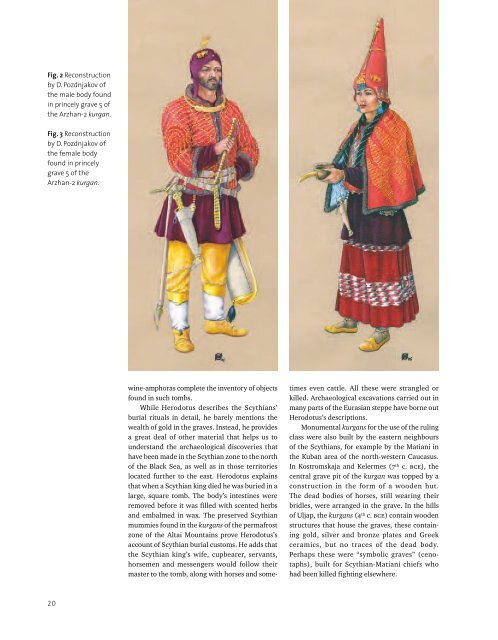Scythian Culture - Preservation of The Frozen Tombs of The Altai Mountains (UNESCO)
Create successful ePaper yourself
Turn your PDF publications into a flip-book with our unique Google optimized e-Paper software.
Fig. 2 Reconstruction<br />
by D. Pozdnjakov <strong>of</strong><br />
the male body found<br />
in princely grave 5 <strong>of</strong><br />
the Arzhan-2 kurgan.<br />
Fig. 3 Reconstruction<br />
by D. Pozdnjakov <strong>of</strong><br />
the female body<br />
found in princely<br />
grave 5 <strong>of</strong> the<br />
Arzhan-2 kurgan.<br />
wine-amphoras complete the inventory <strong>of</strong> objects<br />
found in such tombs.<br />
While Herodotus describes the <strong>Scythian</strong>s’<br />
burial rituals in detail, he barely mentions the<br />
wealth <strong>of</strong> gold in the graves. Instead, he provides<br />
a great deal <strong>of</strong> other material that helps us to<br />
understand the archaeological discoveries that<br />
have been made in the <strong>Scythian</strong> zone to the north<br />
<strong>of</strong> the Black Sea, as well as in those territories<br />
located further to the east. Herodotus explains<br />
that when a <strong>Scythian</strong> king died he was buried in a<br />
large, square tomb. <strong>The</strong> body’s intestines were<br />
removed before it was filled with scented herbs<br />
and embalmed in wax. <strong>The</strong> preserved <strong>Scythian</strong><br />
mummies found in the kurgans <strong>of</strong> the permafrost<br />
zone <strong>of</strong> the <strong>Altai</strong> <strong>Mountains</strong> prove Herodotus’s<br />
account <strong>of</strong> <strong>Scythian</strong> burial customs. He adds that<br />
the <strong>Scythian</strong> king’s wife, cupbearer, servants,<br />
horsemen and messengers would follow their<br />
master to the tomb, along with horses and sometimes<br />
even cattle. All these were strangled or<br />
killed. Archaeological excavations carried out in<br />
many parts <strong>of</strong> the Eurasian steppe have borne out<br />
Herodotus’s descriptions.<br />
Monumental kurgans for the use <strong>of</strong> the ruling<br />
class were also built by the eastern neighbours<br />
<strong>of</strong> the <strong>Scythian</strong>s, for example by the Matiani in<br />
the Kuban area <strong>of</strong> the north-western Caucasus.<br />
In Kostromskaja and Kelermes (7 th c. bce), the<br />
central grave pit <strong>of</strong> the kurgan was topped by a<br />
construction in the form <strong>of</strong> a wooden hut.<br />
<strong>The</strong> dead bodies <strong>of</strong> horses, still wearing their<br />
bridles, were arranged in the grave. In the hills<br />
<strong>of</strong> Uljap, the kurgans (4 th c. bce) contain wooden<br />
structures that house the graves, these containing<br />
gold, silver and bronze plates and Greek<br />
ceramics, but no traces <strong>of</strong> the dead body.<br />
Perhaps these were “symbolic graves” (cenotaphs),<br />
built for <strong>Scythian</strong>-Matiani chiefs who<br />
had been killed fighting elsewhere.<br />
20
















